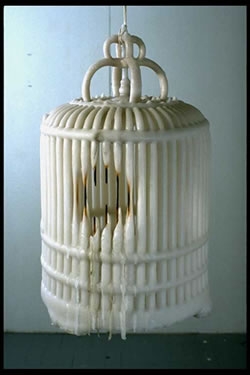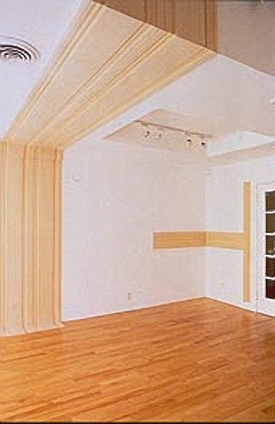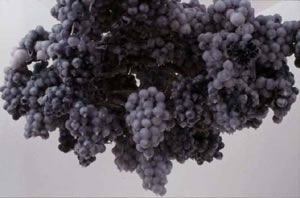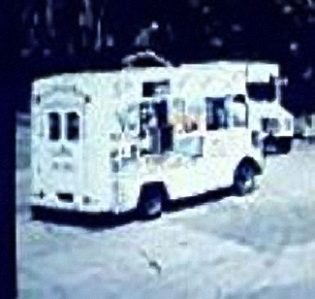Feature: Reviews
High Concept Hand Work
Tony Tredway
a.o.v.
March 23-April 28, 2001
Robert Ortbal
Pond
April 6-29, 2001
Euan MacDonald
Jack Hanley Gallery
April 4-May 5th, 2001
Three shows late this Spring played intriguingly against the grain of the digital deluge of SFMOMA’s blockbuster, 010101. Utilizing simple, low tech, or industrial age methods, these three artists preferred conceptual sophistication to early-adopter digital technology. Almost anti virtual, the works embraced the every day, creating an emblematic connection between these three gallery shows and making for an intimate but palpably physical viewing experience.
Tony Tredway’s ongoing project of transforming finely executed home interior craftsmanship to profound gallery installation effect continued at a.o.v. Tredway used a synthetic material called UltraLight, a product that has no grain, to create a decorative interior molding making a double stripe up the wall and then across the ceiling. synthetic decorative interior molding to create a double stripe running along the center of the floor, making a right angle up the wall and then across the ceiling. The buttery brown surface of the modern facsimile of the routed wood original layered an uncomfortable feeling of novelty over our familiar relationship with a popular domestic San Francisco interior detail. Rather than framing our lives and our furnishings like the piped icing on a cake, this familiar molding placed so radically differently, drew all attention to itself, reiterating the importance of form, surface, and placement. The vertigo-inducing stripe of molding ramped up the wall and onto the ceiling in a fast physical arc, a nod to skateboard culture. Tredway succinctly pulls the references together in the title: Proud: A builder’s term, proud indicates a projection of something beyond the plane from which it emerges; a standing up of the subject over the profile of the other.
Robert Ortbal has been making artwork for 12 years using humble materials to great effect. In Seeing is Believing his work dealt more directly with the spiritual, ritual, transubstantiation, and signs of the soul. Two powerful pieces dominated the gallery space witha distinct quietude. In Candelabra (2001) a large candelabra of deep purple grapes hung from the ceiling, suffusing the space with a sweet scent.The entire candelabra had been covered in wax, protectively coating the whole and allowing the fermentation to take place within. The mass of ripening fruit hung in an arrangement heavily Romantic in its associations, recalling the “natural” exemplified in the painting of Corot or Chardin, but also the Eucharist and transubstantiation, and the harvest. The work created a strange dissonance as an air of cultural sophistication and medieval sanctity aroused more current political awarenesses, like plight of the grape harvesters in California, and the degradation of the environment by the wine industry north of San Francisco. Similar complexities of associations are aroused in Release, (2000) a bird cage heavily coated in wax; the absence of a bird within creating a poignant and foreboding presence.
Jack Hanley split his gallery space in two for a concise show of little drawings on paper and two video projections by Euan Mac Donald, a Toronto artist who recently left SF for Los Angeles. Small pen and ink drawings in modest frames described mundane images in haunting locales, indefinite goings on. In a deadpan depiction from a voyeuristic viewpoint, a dramatic scene of a man with his boot on fire in a dark clearing evokes the panic of a night spent in the woods by a city dweller, or other, more deeply psychological and emotional implications.
In one of his most powerful works to date, Three Trucks (2001) a video projection describes an encounter at a crossroads between 3 Southern California ice cream trucks. They approach each other slowly, in deliberate movements like those cherished in avant-garde dance and operatic suspense films and Matthew Barney. Deliberately and ridiculously, the merry-go round music of the individual trucks cycle and blend to create a modernist kitsch symphony. The eerie strains of “It’s a small world after all” materialize. Is the Mexican music more familiar, or does the indecipherable carousel music dominate? Does what we hear depend on the cultural bias of the viewer? MacDonald’s intentionally modest means create a poignant and humorous effect. This short, simple video raises complex issues of conflict and resolution, anonymity and recognition of the self, cultural confluence and dissonance, and fear and avoidance with the metaphor of a silly but meaningful coincidence.
Of the three, MacDonald “crossed over” by his inclusion in 010101. In the context of that technologically complex show, MacDonald chose paradoxically simple means. It seems too simple that the artist would merely duplicate the videotaped image of a jet plane to create two planes flying in tandem, arousing our suspicion of how much truth lies in the image. The doubling of the jet, the inference of endless refueling or endless sex eerily predates the debacle of the delivery of the heavy jet fuel payload by two subverted commercial jetliners. Perhaps art is, once again, not so different from life. The act of climbing a mountain give rise to experiences of the natural physical world and of our bodies that are never realized through media. Media, however, offers us the wonder of seeing sites without physically traveling anywhere, and the likelihood of seeing things that we will never experience. The differences in mediated versus unmediated experience mirrors the difference between viewing highly mediated artwork and experiencing a physically grounded one. The immersive, spectacular value of the highly mediated artwork does not exercise a moral difference from artwork like Tredway, Ortbal and MacDonald’s. Each brings something the other cannot; the difference lies in the experience.
Tony Tredway at a.o.v. March 23-April 28, 2001; for more information call Robert Ortbal was at Pond, April 6-29, 2001; for more information call 415.437.9151, visit www.mucketymuck.org. Euan MacDonald was at Jack Hanley Gallery, April 4-May 5th, 2001. For more information visit http://www.jackhanley.com




